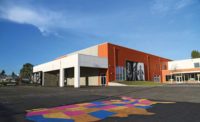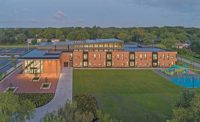Sandy Hook School
Newtown, Conn.
Best Project
Owner: Town of Newtown, Conn.
Architect: Svigals + Partners
Construction Manager: Consigli Construction Co.
Structural Engineer: Michael Horton Associates Inc.
Civil Engineer: BL Cos.
MEP Engineer: BVH Integrated Services Inc.
Interior Designer: Lynn Brotman Interior Design
Landscape Architect: Richter & Cegan Inc.
Program Manager/Owner’s Representative: STV | DPM
Geotech Engineer: Langan Inc.
Commissioning: OLA Consulting Engineers; Sustainable Engineering Solutions LLC
Consultants: Atelier Ten USA LLC (Lighting/LEED); Acentech Inc. (Acoustics); DVS (Acquired by Ross & Baruzzini Inc.) (Security)
The rain garden along the undulating wood rain screen at the LEED Gold-certified elementary school—a replacement for the Sandy Hook school where 20 children and six adults were killed nearly five years ago—is a natural filter for roof runoff as well as a tool to teach students about plant and animal ecology. But the landscaping is not only about ecology and teaching. It is a buffer between the parking lot and the building—a critical element of the passive security system designed to help protect faculty, staff, students and parents in a manner sensitive to the survivors of the Dec. 14, 2012, shooting.
Hidden cameras, motion sensors, impact-resistant windows and walls are also placed strategically throughout the grounds. The ground floor of the 87,000-sq-ft building, which accommodates more than 500 students, is elevated a few feet to prevent an assailant from looking inside.
Designed to resemble fingers of an open hand, the classroom wings jut off the back of the building to create protected courtyards. Entire corridors and classrooms can be completely locked down. Hidden gates can secure the property, and perimeter fences are constructed from cast-concrete blocks that resemble traditional New England stone walls.
The building’s security system was developed in tandem with state and federal efforts to overhaul school-security building codes.
Local officials voted to raze the old school and rebuild on the same site before the design process for the replacement school began. A town committee consisting of some 50 residents participated in several design workshops. The committee helped designers relocate the driveway so that it wouldn’t be a constant reminder of the area where adults waited for children after the shooting.
“They did a really good job including all these stakeholders and parents and still managed to deliver a product on schedule,” one Best Projects judge said.
The 20-month, fast-tracked construction manager at-risk project was completed for the 2016-17 school year. The $48.8-million project was also $1.2 million under budget. The contractor saved time and money by using deep dynamic compaction to improve the sandy soil that gives the town its name.
During the project, the building team worked with teachers and parents to hold four KidsBuild! workshops for Sandy Hook students. Hands-on activities introduced students to design, engineering and construction logistics.
In one workshop, students explored natural items from the site and made line drawings, which they used to create patterns for engraved wood panels set under the school’s front windows.
One judge said he graded the project on its “merits as a construction process …. They did a great job. It’s a beautiful project.” The same judge added, “I loved that the design had the [classroom] wings coming out like they were arms wrapping themselves around” the students as they enter.
Related Article: Innovation Permeates Region's Top Work







Post a comment to this article
Report Abusive Comment